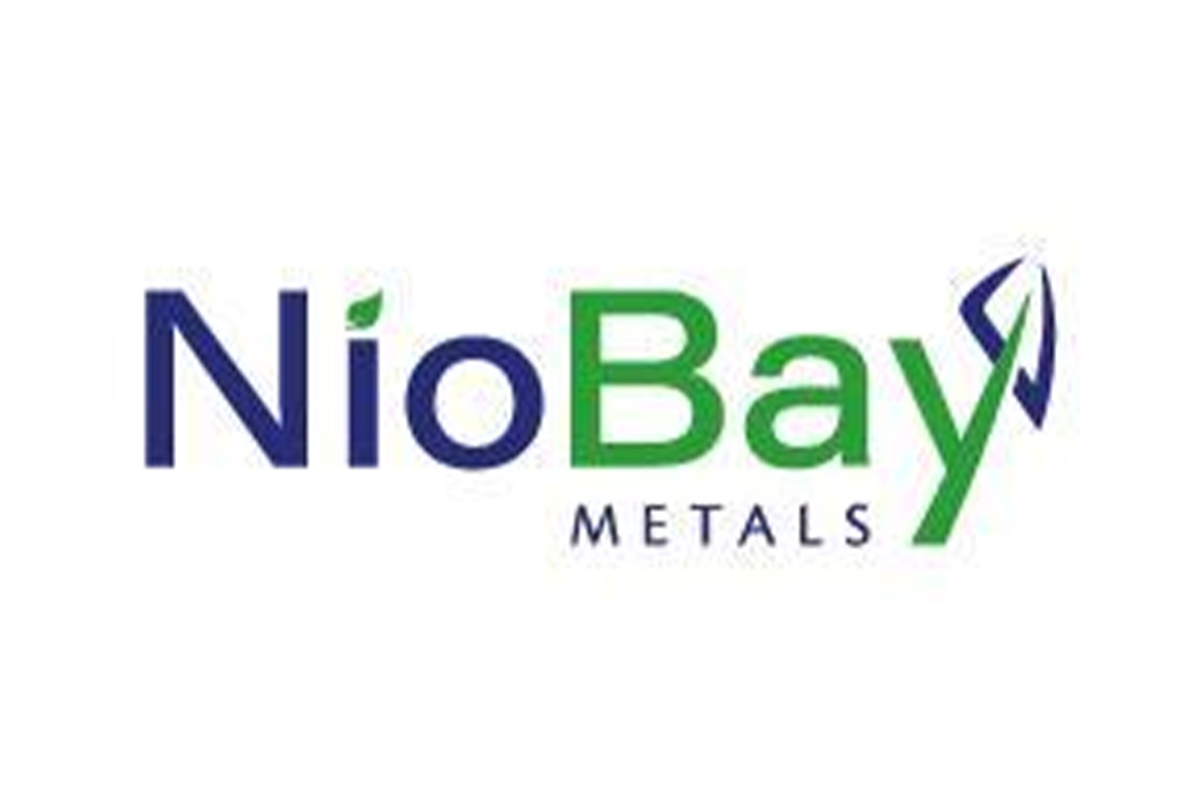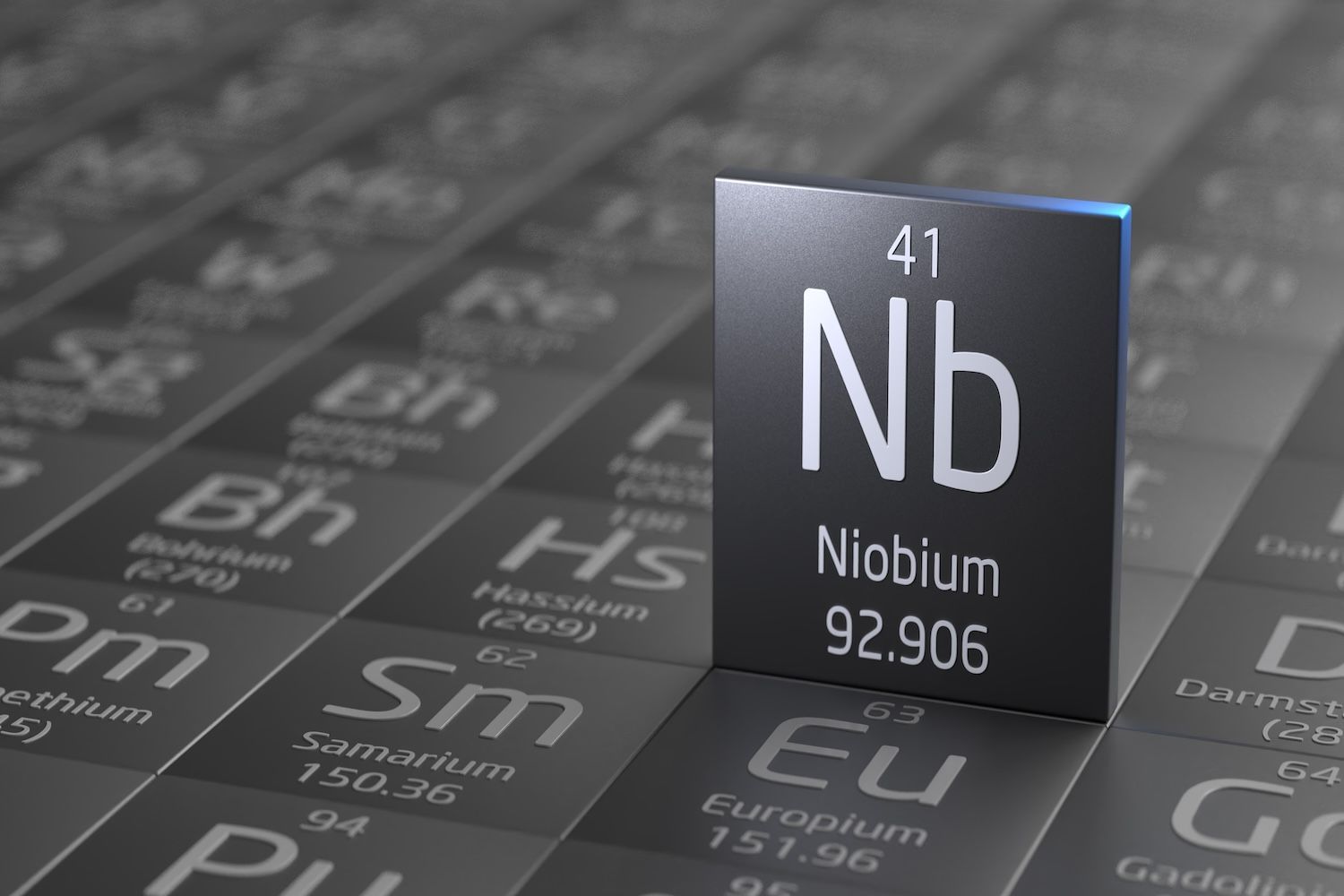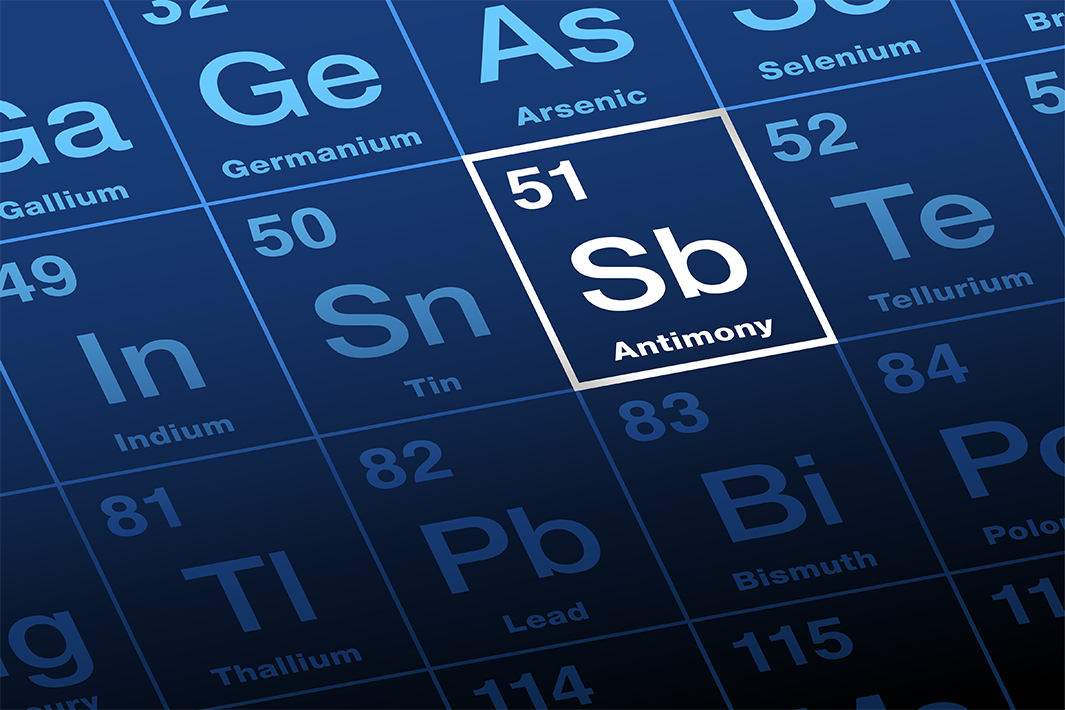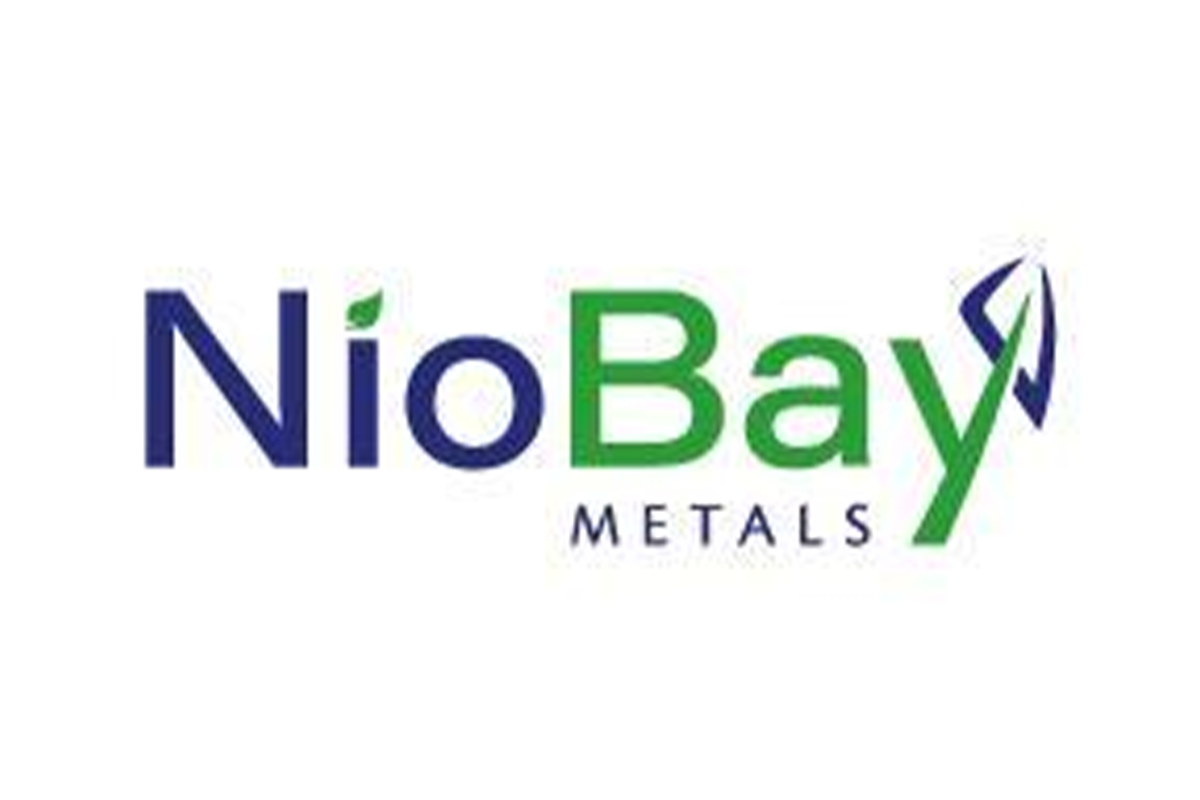
February 26, 2025
NioBay Metals Inc. (“NioBay” or the “Company”) (TSX-V: NBY) (OTCQB: NBYCF) is proud to announce that it has intercepted titanium in several of the surface drill holes carried out in Zone 1, on the Foothills Property, located on the lands of the Séminaire de Québec.
The Company had filed an application for authorization for impact projects with the Ministry of Natural Resources with the aim of carrying out a drilling campaign as soon as authorization is received. Below, the Company provides the results of the TiO2 mineralized zones of interest, from the fall 2024 exploration campaign.
The Foothills project is located north of Saint-Urbain, 100 km north of Québec City and 90 km south of Saguenay (La Baie region), Québec. The project covers an approximate area of 285 km2 and includes five separate claim blocks. It covers most of the contact of the intrusive zone known as the Saint-Urbain anorthosite.
It should be noted that the drilling work generated 32.14 tonnes of CO2 equivalents. A donation was granted to Carbone Boreal (Université du Québec à Chicoutimi) as compensation.
Table of Results
Intersections calculated for a cut-off grade of 8% Ti, a minimum length of 1 m and a maximum internal dilution of 1 m.
| Drill Hole | From (m) | To (m) | Length (m) | Dilution (m) | TiO2 (%) |
| 1625-24-002 | 89.75 | 153.00 | 63.25 | 1.00 | 10.57 |
| 1625-24-002 | 185.00 | 186.80 | 1.80 | 0.00 | 17.09 |
| 1625-24-002 | 220.80 | 226.55 | 5.75 | 0.00 | 22.36 |
| 1625-24-003 | 135.25 | 149.00 | 13.75 | 0.00 | 12.62 |
| 1625-24-003 | 151.00 | 156.00 | 5.00 | 0.50 | 19.13 |
| 1625-24-003 | 172.30 | 180.00 | 7.70 | 0.00 | 14.44 |
| 1625-24-004 | 154.10 | 158.40 | 4.30 | 0.00 | 14.73 |
| 1625-24-006 | 16.50 | 18.80 | 2.30 | 0.00 | 9.22 |
| 1625-24-006 | 25.00 | 30.45 | 5.45 | 0.70 | 11.76 |
| 1625-24-006 | 37.00 | 38.00 | 1.00 | 0.00 | 8.01 |
| 1625-24-006 | 48.00 | 49.00 | 1.00 | 0.00 | 14.60 |
| 1625-24-007 | 44.20 | 47.00 | 2.80 | 0.00 | 11.14 |
| 1625-24-007 | 49.00 | 62.65 | 13.65 | 0.00 | 10.56 |
June 2024 prospecting area and sample locations
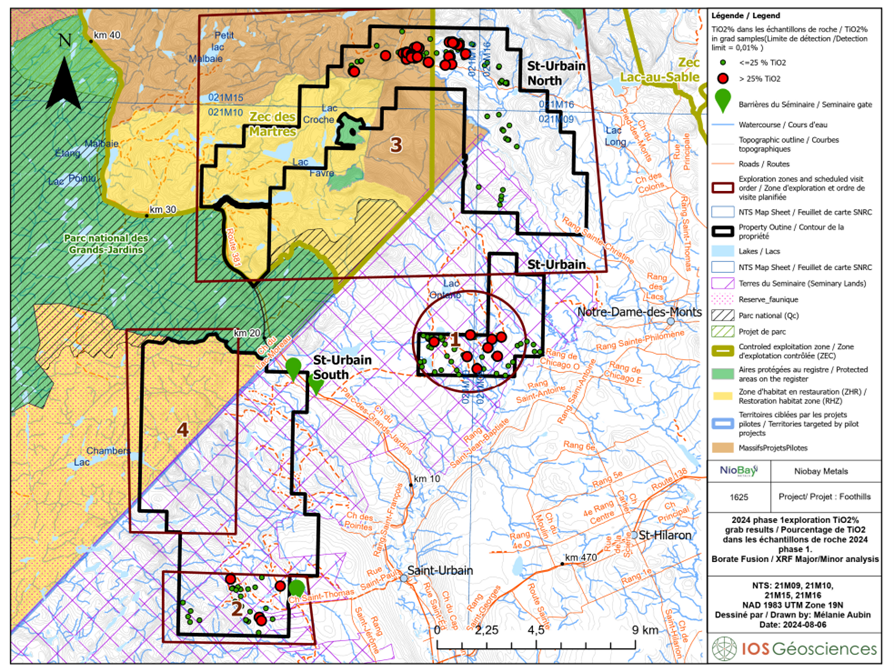
Map 2: Location of Drill Sites
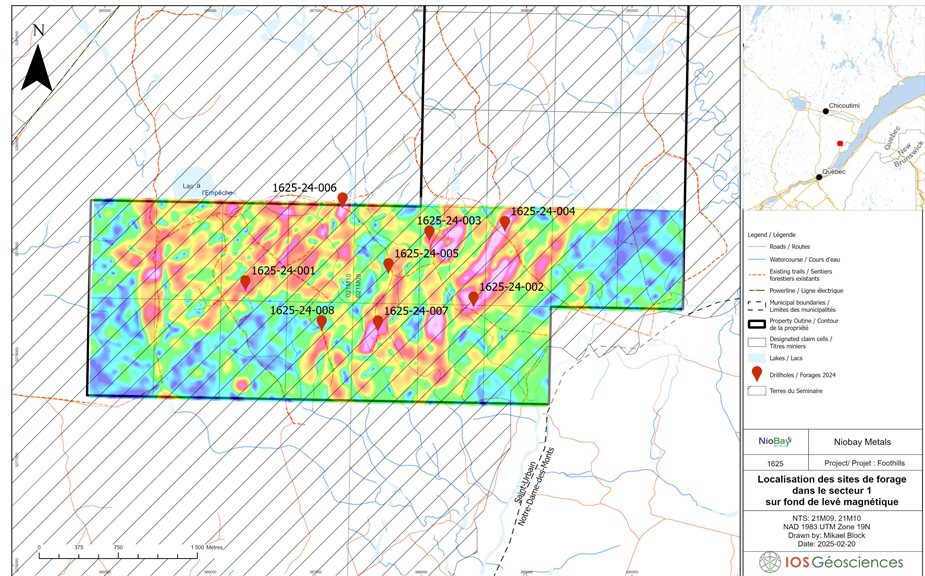
Message from the President
“We are finally able to present our results from Zone 1. We were pleasantly surprised by the grade in certain holes. The next step will be to drill on a section of Zone 3. The application for authorization for this zone have been filed. Remember that sector 3 has demonstrated very good surface values in titanium (Press release of August 7, 2024)”, concluded Mr. David.
PDAC 2025
NioBay will be at PDAC again this year from March 2nd to the 5th inclusively, at the Toronto Convention Centre. Come meet us at booth 3015.
Qualified Persons
This press release has been reviewed and approved by Mr. Mikael Block, P.Geo., a Qualified Person under National Instrument 43-101. Mr. Block is a Project Manager employed by IOS Services Géoscientifiques.
About NioBay Metals Inc.
NioBay aims to become a leader in the development of mine(s) with low carbon consumption and responsible water and wildlife management practices while prioritizing the environment, social responsibility, good governance, and the inclusion of all stakeholders. Our top priority, which is critical to our success, is the consent and full participation of the Indigenous communities in whose territories and/or on ancestral lands we operate.
In addition to others properties, NioBay holds a 100% interest in the James Bay Niobium Project located 45 km south of Moosonee, in the Moose Cree Traditional Territory of the James Bay Lowlands in Ontario. NioBay also holds a 72.5% interest in the Crevier Niobium and Tantalum project located in Québec and on the Nitassinan territory of the Pekuakamiulnuatsh First Nation. The Company has also the option to acquire an 80% interest in the Foothills project, a titanium-phosphate project located near the former St-Urbain mine site in Quebec.
About Titanium
Titanium (Ti) is as strong as steel, but much less dense. It is therefore important as an alloying agent with many metals, including aluminum, molybdenum and iron. These alloys are mainly used in aircraft and spacecraft because of their low density and ability to withstand extreme temperatures. They are also used in sports equipment, laptops, bicycles and medical prostheses. Recently, this metal has been used in some battery components.
Cautionary Statement
Certain statements contained in this press release constitute forward-looking information under the provisions of Canadian securities laws including statements about the Company's plans. Such statements are necessarily based upon a number of beliefs, assumptions, and opinions of management on the date the statements are made and are subject to numerous risks and uncertainties that could cause actual results and future events to differ materially from those anticipated or projected. The Company undertakes no obligation to update these forward-looking statements in the event that management's beliefs, estimates or opinions, or other factors should change, except as required by law.
Neither the TSX Venture Exchange nor its Regulation Services Provider (as that term is defined in the policies of the TSX Venture Exchange) accept responsibility for the adequacy or accuracy of this release.
FOR MORE INFORMATION, CONTACT:
NioBay Metals Inc.
Jean-Sébastien David, P.Geo., MPM
President & CEO
jsdavid@niobaymetals.com
www.niobaymetals.com
Kimberly Darlington
Investor Relations
kimberly@refinedsubstance.com
Tel: 514-771-3398
Photos accompanying this announcement are available at
https://www.globenewswire.com/NewsRoom/AttachmentNg/29b6747d-ce60-40ad-b263-edd85dcc6921
https://www.globenewswire.com/NewsRoom/AttachmentNg/79550acc-c4ce-4e20-ae0d-13463ccafa16
NBY:CA
The Conversation (0)
20 October
NioBay Improves the Concentrate Content by 56% as Compared to Historical Metallurgical Results
Niobay Metals Inc. (" NioBay" or the " Company" ) ( TSX-V: NBY) ( OTCQB: NBYCF ) is proud to announce the highlights of its metallurgical work carried out by SGS in Quebec City. This work was made possible thanks to a grant received under the Mining Exploration Support Program for Critical and... Keep Reading...
09 October
NioBay Confirms Receipt of an Exploration Permit for its James Bay Niobium Project
Niobay Metals Inc. (" NioBay" or the " Company" ) ( TSX-V: NBY) ( OTCQB: NBYCF ) confirms receipt of a notice from the Ontario government. This notice announced the granting of a new exploration permit for the James Bay Niobium Project located 42 km south of the town of Moosonee, Ontario. It... Keep Reading...
11 September
NioBay Confirms Extension of Mineralization on Its Crevier Project and Intersects Rare Earth Elements in Its Northernmost Holes
Niobay Metals Inc. ("NioBay" or the "Company") ( TSX-V: NBY ) ( OTCQB: NBYCF ) is proud to announce the first results of the 2025 summer drill campaign (the "2025 Campaign") on the Crevier niobium (Nb) and tantalum (Ta) project (the "Crevier Project"), of which it owns 72.5%. The Crevier Project... Keep Reading...
8h
Rare Earths Oxide Produced from Halleck Creek Ore-Major Technical Breakthrough
American Rare Earths (ASX: ARR | OTCQX: ARRNF | ADR: AMRRY) (“ARR” or the “Company”) has successfully completed another critical stage in its mineral processing program by producing a mixed rare earths oxide (“MREO”) using the updated preliminary PFS mineral processing flowsheet. HighlightsRare... Keep Reading...
27 November
UK Lists Australia as Potential Critical Minerals Partner
The United Kingdom is looking at building bilateral critical minerals partnerships with various countries, including Australia.On Tuesday (November 25), UK Industry Minister Chris McDonald was said to have mentioned a collaboration with Australia under the AUKUS defence pact, according to a news... Keep Reading...
26 November
Locksley Resources Limited Drill Program Operations Commence at El Campo
Perth, Australia (ABN Newswire) - Locksley Resources Limited (ASX:LKY,OTC:LKYRF) (FRA:X5L) (OTCMKTS:LKYRF) provided a significant operational update for its Mojave Project in California, confirming that the project has now transitioned into the drilling program phase. HIGHLIGHTS - Activities... Keep Reading...
25 November
WA1 Resources’ Luni Niobium Asset Gains Major Project Status
WA1 Resources (ASX:WA1) said its flagship Luni niobium project has received major project status.The designation from the Australian government highlights Luni’s national significance and its potential to strengthen the country's economy. WA1 said major project status also provides case... Keep Reading...
24 November
Antimony's Rise: A Strategic Shift
As global powers race to secure the raw materials needed to fuel their energy transition goals, strengthen national defense, and maintain technological leadership, a once-overlooked element is stepping into the spotlight as the next strategic opportunity: Antimony. Antimony has a... Keep Reading...
24 November
Locksley Strengthens U.S. Defense Supply Chain Strategy with Appointment of Lockhead Martin Materials Leader to Advisory Board
Locksley Resources Ltd. (ASX: LKY,OTC:LKYRF; OTCQX: LKYRF) announced the company has appointed Stacy Newstead to its advisory board as Strategic Advisor-Materials Strategy. Ms. Newstead brings more than 20 years of experience across U.S. government, defense and industrial sectors. She currently... Keep Reading...
Latest News
Latest Press Releases
Related News
TOP STOCKS
American Battery4.030.24
Aion Therapeutic0.10-0.01
Cybin Corp2.140.00

